Game designers are responsible for conceptualizing a game’s vision and feel by leading the design of its systems, rules, mechanics, gameplay, user experience, plot, characters, obstacles, and settings. To become a game designer you must learn foundational game design skills, improve those skills through analyzing games and developing a design framework, and gain experience through game jams, prototyping, and modding.
Becoming a game designer means meeting or exceeding the job requirements for a junior game design position. Find guidance from mentors and network with video game industry veterans to help you stand out from other applicants and know what to expect.
Anyone who makes a game is a game designer. Landing video game design jobs is more of a challenge for those without a roadmap. I’ve witnessed a common pattern of steps separating those who broke into the video game industry and started their game design career, and those who didn’t throughout my two-decade-long career.
Below I’ve listed 7 steps to take you from dreaming about game design to doing it.
1. Play games while thinking critically
Develop and improve your design skills by playing games with a critical-thinking mindset, adopting your own design framework, getting hands-on with game jams, and making connections in the industry.
Game designers need to be aware of what makes some games engaging and others boring. You can’t depend on intuition as a designer. You must play and analyze games, learn from those experiences, and seek the guidance of mentors.
Play games (and break them down): Analyzing as you play helps you develop insights into a game’s problems and strengths. Observe and analyze how the games are put together. Critical observation allows you to build a library of patterns concerning how different developers implement design principles. You can then apply these insights to your own design work.

Playing games is important enough that Riot has a Play Fund that provides employees with a budget of $25/month to spend on games to study through play. I spent 20-25 hours per week playing games prescribed by my mentor Tom Cadwell (Riot Games’ current Chief Design Officer) when I started.
Develop a design decision framework: Skilled game designers operate using a universal process and framework that means they can repeat successes and avoid failures. Unskilled designers base decisions on their personal player archetype, meaning they depend on the same solutions to every problem. A framework allows you to identify root design problems from feedback, provide practical solutions, and effectively communicate issues and solutions to your team.
You earn trust, respect, and the ability to do even more when you’ve identified and resolved problems, showing people the quality of your iteration and execution. I found a way to make the Netherdrakes fight while flying in the outside world while working on World of Warcraft—something the programming team insisted was impossible outside of a locked raid zone.
The fighting Netherdrakes earned me a lot of respect from the design team and I was asked to do even more ‘impossible’ things in the future. I used this credibility to build better tools, including a designer menu that made every designer’s daily life easier.
Get mentored by practicing professionals: Having someone experienced giving you guidance and feedback can drastically shorten your learning curve as a game designer. I was lost until my mentor Tom Cadwell started to guide me in the right direction. His guidance led me to work on the skills that got me hired by Blizzard.
2. Learn how to use a game engine
Learn how to use a game engine and you can start designing games. Many people do this without paying for any courses. Pick up the basics of a single engine and you can begin the process of turning ideas in your mind into playable prototypes.
Get started quickly with beginner-friendly engines like Unity, Godot, and RPG Maker, or go more in-depth with a pro-level engine like Unreal or CryEngine. Check out these game engines for beginner breakdowns to make an informed decision.
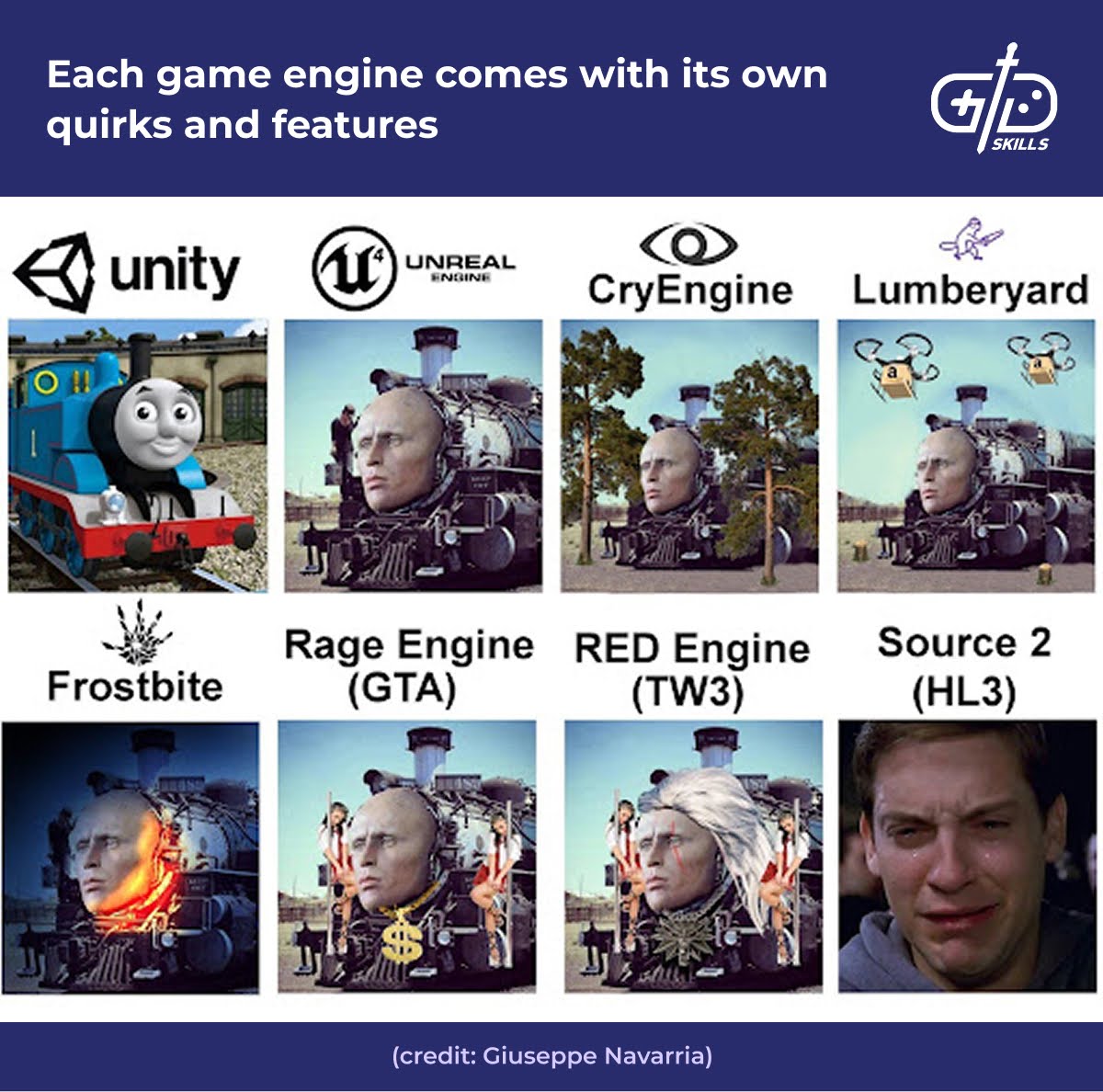
Unity, Unreal, Godot, and Game Maker offer free online tutorials that teach you the basics of their engines. Game Maker Studio 2, Stencyl. RPG Maker, and Construct 3 all feature either a monthly flat rate or a single, upfront purchase. All engines mentioned feature in-depth tutorial videos, forums, and active communities.
I started using Graal Online’s editor (pictured below) when I was 13 years old. Later, I picked up Unity. Studios judge your proficiency with game engines on how well you can implement fun experiences using them and your ability to make things look pretty. Get hands-on experience with game engines to practice making pieces that are fun to play. Don’t wait until you know everything, start making playable experiences ASAP.
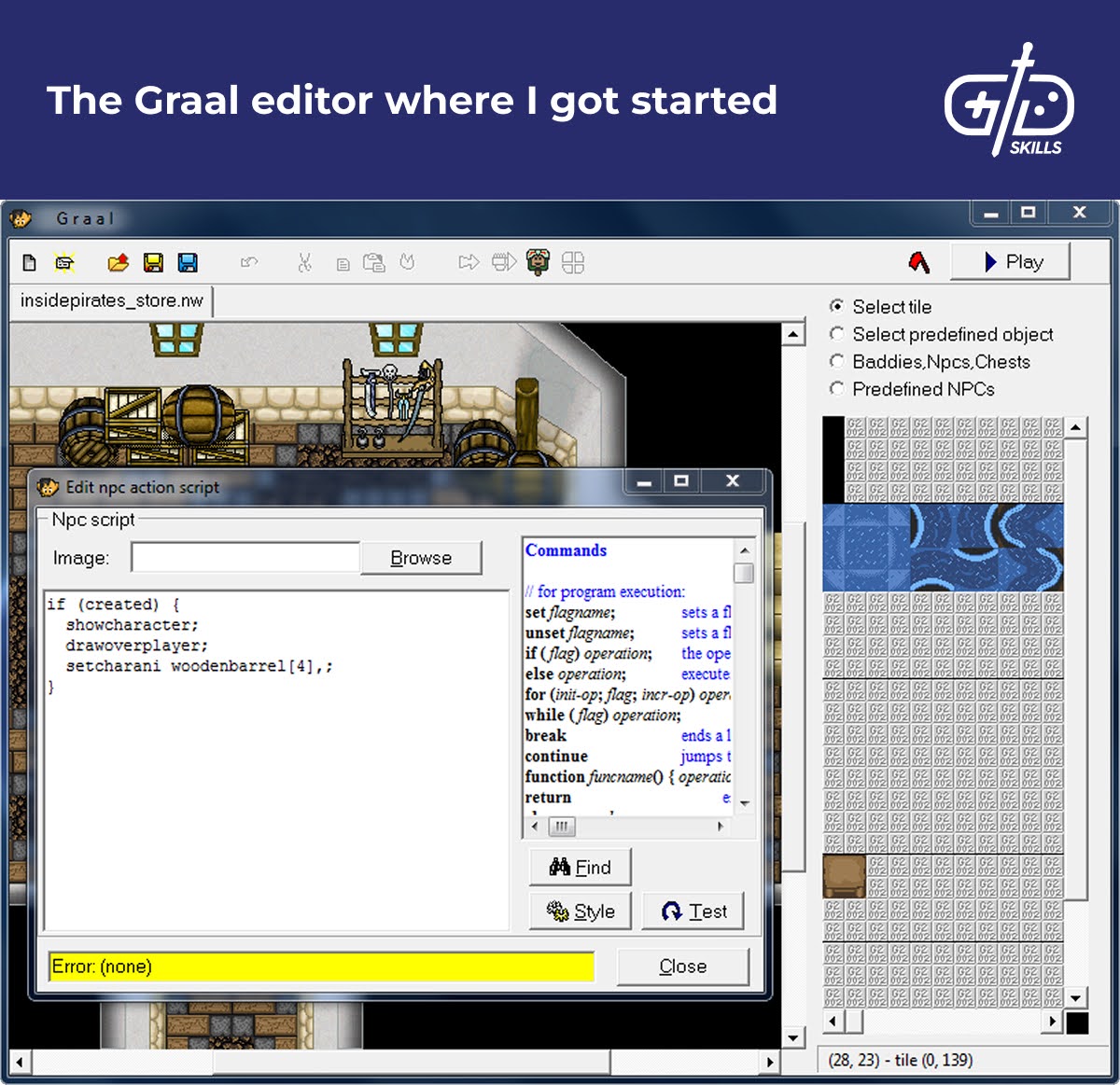
3. Learn online video game courses
Online video game courses are a valuable resource for discovering all about game design and its related skills. I studied several free courses on YouTube before investing in a paid course led by Earthworm Jim.
Learn online game development courses to equip yourself with the design skills needed to get started in the industry. Online courses teach the high-level process of turning an abstract idea into a playable game and how to iterate from there.
Platforms like Udemy, Coursera, and Domestika, offer courses on the fundamentals of game design. Online learning platforms select lecturers who’ve worked on games with brand name recognition. Choose a course presented by a game designer who’s worked on a game you connected with.
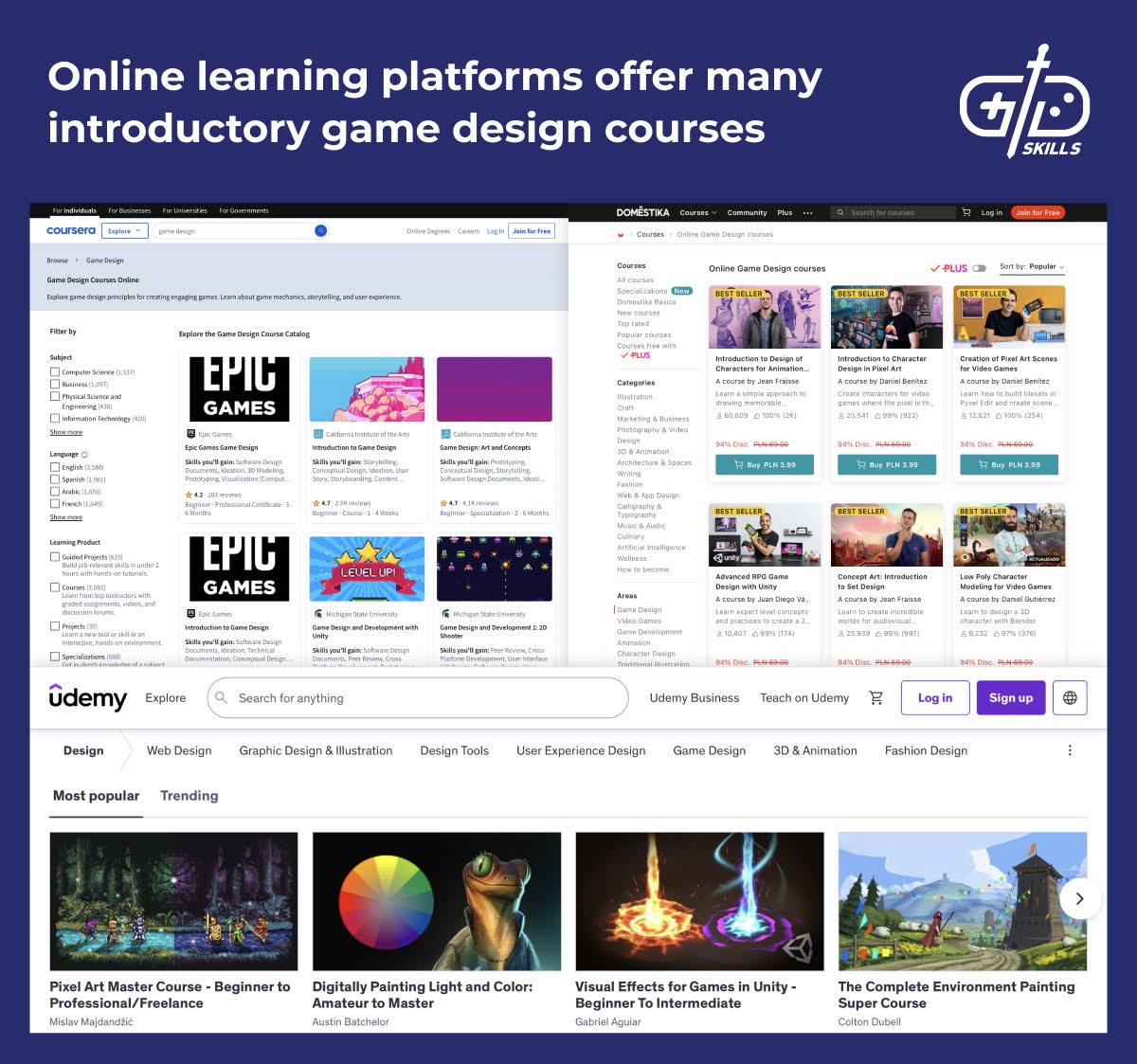
Online game design courses range from pre-recorded video lessons with worksheets, to fully interactive face-to-face lectures with graded assignments, and question-and-answer sessions. Shorter, non-interactive, pre-recorded game design courses range from $40 to $60 but often go on sale for $10 to $20. More interactive 7-10 week courses range from $1500 to $3000.
Online introductory courses focus on high-level material and concepts. These courses are useful but generalized because video game design education isn’t set in stone. Reading game design books and using free online resources teaches the same material to self-motivated learners for less expense.
4. Obtain a degree
Obtain a Computer Science (CS) or Software Engineering (SE) degree to demonstrate you understand the principles underpinning video game design. A degree in CS or SE isn’t a must-have, but it shows a game designer has the discipline to learn complex systems and processes.
Get a game design from a college like Stanford or the University of Southern California and enjoy an international reputation recognized by game studios. Some qualifications are less useful because they’re taught by lecturers who don’t work in the industry. (Or haven’t for a long time.)
Search for university programs taught by professionals who are active in the industry when selecting a college. Some of what’s taught in less reputable degrees is either out-of-date or available in a cheaper (often free), more convenient online format.
5. Get game design experience
Getting game design experience before your first job comes from game jams, projects with friends, prototyping, modding, and leveraging AI to create portfolio pieces. Game design experience is necessary to learn, progress, and achieve the competence level game studios look for.
With game design experience, starting small is OK—there’s no better way to learn than by applying knowledge to real video games. Game design is a maker’s craft. Studios will want to see your portfolio to see what you’ve made, even if your projects aren’t commercial releases. You must have some games to show to be considered a viable candidate.
Here are ways to get game design experience before landing your first paid position.
Participate in game jams: Put some simple game ideas together without coding using tools like Blueprints and Playmaker, even if you don’t have someone who can program per se!
Projects with friends: Develop your skills with short week-long game-making projects with a couple of friends.
Non-code-based prototyping: Make a board or card game to skip the coding hurdle completely. You can learn most of the fundamental principles of video game design this way.
Use AI to generate code and art: Leverage AI to allow you to focus mainly on learning design skills. AI has lowered the barrier to entry to asset and code creation.
Mod games: Use modding as an effective practice tool, especially for learning content design. You’re essentially using the same native development tools the game’s devs to make changes to popular games with established player base.

I’ve created the Build a Game Challenge to help complete novices who feel intimidated by all the above options or want to learn the fundamentals of game design foundations before code. I created this resource to help you get started as easily as possible.
The Build a Game Challenge includes templates, step-by-step guidance, examples to reference, a Discord support channel for feedback and testing, and there’s no code required. This challenge contains everything you need to turn an idea into a virtual playable tabletop game in 6 days.
6. Meet the job requirements
To meet the requirements for a junior game design position, ideal candidates display a mix of technical, artistic, and writing skills. The first job you’ll qualify for when you start your game design career will be as a game design intern, assistant game designer, associate game designer, or junior game designer.
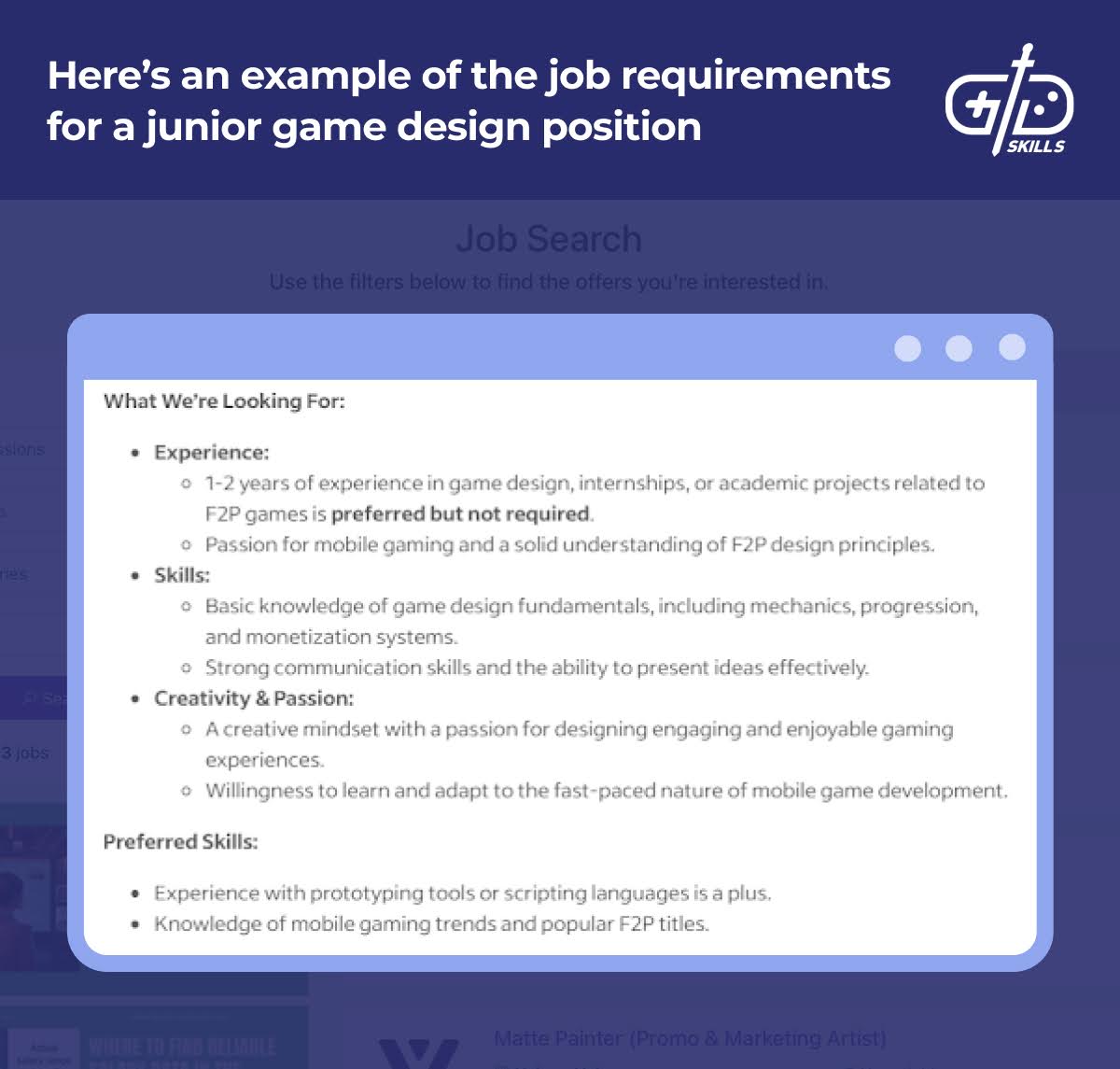
What a game designer does demands a mix of intellectual curiosity and critical thinking. Be yourself and represent your strengths honestly at interviews. Showcasing your skills is more important than what school you attended because game studios are looking at your demonstrable work when recruiting for junior game design roles. Include only your best work in your portfolio and focus on pieces that show your unique talents.
7. Prepare for the game designer’s responsibilities
Prepare for the junior game designers’ responsibilities by creating content and participating in brainstorming and document generation sessions for the indy and game jam projects you’re involved with. Game designers’ responsibilities include using coding, programming, testing, writing, and imagination to achieve their vision, with the help of their technical and creative staff.
Junior designers don’t tackle large, complex systems. Instead, senior designers assign smaller systems with fewer variables to junior hires. Working on a smaller system allows junior designers to develop ownership over that system without incurring too much risk.
When you start in a junior game design position, the worst mistake you can make is not asking questions and assuming you know exactly what to do. Remember, they don’t expect you to know everything as a junior designer.
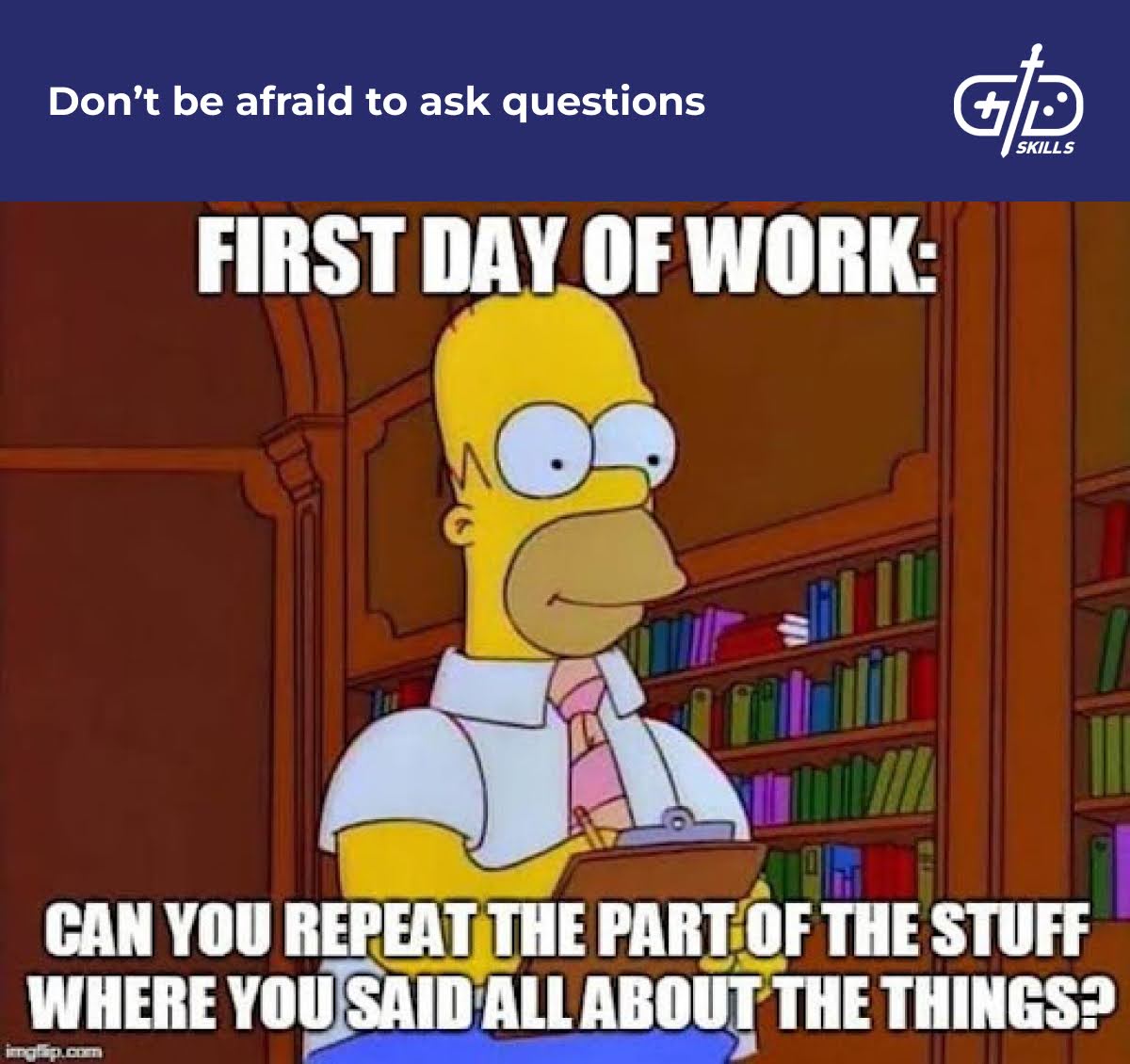
Try to spend your first month and ideally the first year, learning the tribal knowledge of your design team while developing your own game design methodology and philosophy because everything is contextual. Once you understand why things are done the way they are currently, THEN you can start questioning how to change things up!
Remember, it’s a many-year process to grow in design. This doesn’t mean you should put up with a toxic or dangerous working environment though, so take care of your physical and mental health. You won’t be at your best if you burn yourself out.
Network with the game designers at your studio if you work in a field that isn’t game design. See if you can help out or listen to their discussions. You have a lot of opportunities to learn from them, even if you aren’t ready to do the work yet!
8. Try to exceed the qualifications
Exceeding the qualifications in the game industry is a matter of putting work into volunteer or passion projects, refining your portfolio according to feedback, and making connections. Work you do outside of formal qualifications is as important (or more so) than any degree in game design.
Focus on the quality of your portfolio to exceed the qualifications. Here is a fact: You can get hired if you have a portfolio without a degree, but you definitely won’t get hired if you have a degree without a portfolio. Working on mods, indie projects, game jams, TTRPGS, etc, shows that you have the drive and willingness to get your hands dirty—qualities as important as talent for creative industry work.
Another way to stand out from other similarly qualified candidates is networking. Networking with those in the industry allows you to source exclusive game design job opportunities and potentially even get referrals.

Go to game development meetups, if you’re in a big city! Some will just be hobbyists, but others will have actual game developers who you can talk to, ask questions of, and develop friendships.
Be careful not to just glue onto one specific developer who has the job you want though. Meet lots of different developers and learn about their lives, struggles, and interests. If you aren’t in a major city, groups like the Funsmith Club, IGDA, the Indy Games Industry, and many other online groups are available to help you meet others in the same situation.
Do you need a degree to be a video game designer?
No, you don’t need a game design degree, a computer science diploma, or even a bachelor’s degree or one of many online degree programs to be a game designer. Degrees are nice to have, however. The main function of a video game design degree is to put it on your resume. In game design, your resume is only looked at to see if your portfolio is worth reviewing.
Degrees aren’t useless, but here are more pragmatic ways to get hired as a game designer. For example, mine began with writing silly fanfics about Final Fantasy 6. The fanfics led to me making websites and teaching others how to write HTML and java games. My website-making, teaching, and writing snowballed and I found early-level editors to make my own levels. I eventually went to college, got a CS degree, and took all of the game design classes I could. Spoilers: they didn’t exist and were mostly classes on 3D or flocking algorithms.

I ended up in the industry when a lot of my colleagues didn’t. Creating my own projects before formal learning is one of the differences separating us. When I’m hiring junior game designers, it’s a red flag if the applicant has a degree without any meaningful projects to showcase in their portfolio.
How much does a game designer make?
An average game designer salary in the USA is $117K per year, according to Glassdoor’s November 2023 salary data. Salaries in game design will vary significantly across geographic locations, however.
For example, the average salary of a game developer in Dublin is closer to $40K, in Warsaw $38K, and in Singapore $27K. Game designers starting their careers at the very bottom often work a day job while creating a passion project at home, so they don’t show up on average game designer salaries. Like many creative, passion-driven industries, there are all kinds of people working at every end of the scale.


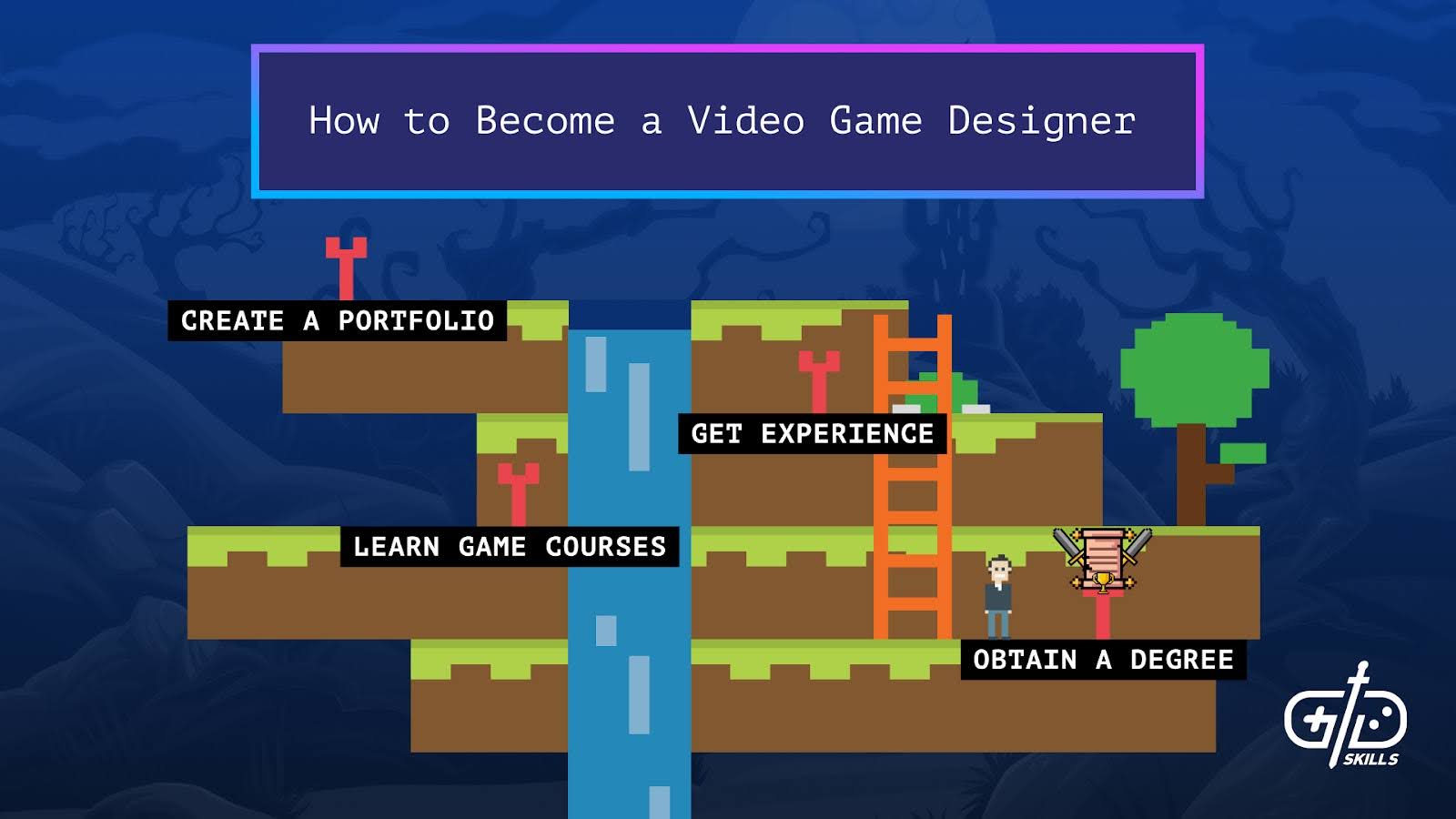








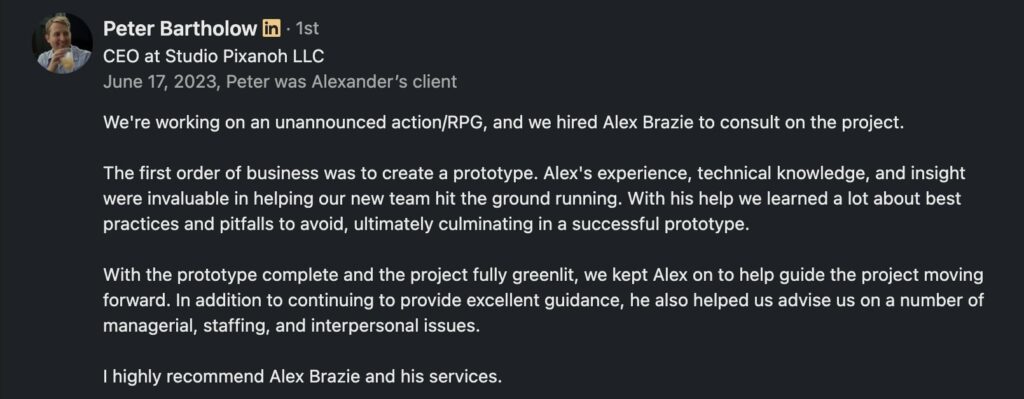

7 Responses
Thank you, I’ve recently been looking for a guide written by an actual game designer for a while. Thank you for this write up!
Very thorough overview on a game designer’s journey!
Great post! I’m interested in get into the game design industry. However I’m more developed on the artistic and musical side. Which positions do you recommend for me?
VFX, game concept art, 3D modeling, animation are great disciplines for music and arts background.
Great thorough guide. I really like the table of contents to help navigate the piece.
Great Post!